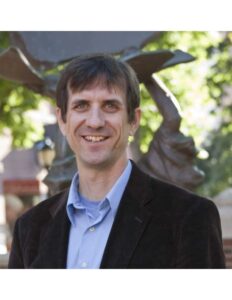
Near Stories and the Paradox of a Charged but Hospitable Classroom
Hospitality does not begin faraway, but near. We learn what hospitality is by reaching out to persons near to us—persons we pass by every day, persons who share our highways and hallways, our sidewalks and side streets.
This past fall, forty-eight leaders from around our community gathered to tell “near stories” to one another about their experience of race and racism, privilege and power in their lives. These community leaders included local judges, superintendents and principals of schools, CEOs of health systems, business owners, college administrators, and, notably, police officers—the very leaders shaping the response to the unholy trinity of Covid-19, systemic racism, and misinformation.
This group of busy, highly educated leaders committed to twelve hours of honest dialogue about the history and ongoing impact of racism in our country and our community. The dialogue followed what is known as a “caring circle” model—a model that requires participants, first and foremost, to listen actively to one another without judgment. That is, it asks us to “hear each other to speech,” as the racial justice activist Nelle Morton exhorted. The difficult realities of our shared life together in the United States—things like our biases, the past and present ways in which we have discriminated against persons based on the identities we decided were most important, the ongoing effects of racial violence and trauma—are not always easy to hear into speech among friends, much less among powerful community leaders.
But the dialogues didn’t start with these difficult topics. The conversations begin with questions designed to reset the frame of the relationships in the caring circle. Participants were no longer their job titles or their positions of formal authority, they were human beings subject in myriad ways to the fundamental need to belong. The circle began: Tell me an experience of when you belonged? Tell me an experience of when you felt excluded?
Participants start by relearning in a highly structured, formal way how to practice hospitality to one another, and this allows them to hear each other to speech about what we know to be some of our most profound, shared needs as human beings: the need to be recognized as whole persons with complex, unique stories that have something to contribute to the “we are” part of “I am because we are.” At the same time, circles emphasize the need to recognize in others something of the “I am”—something that connects who I am deeply to who you are you, to what it means to be human. That is, they start with near stories that illumine in their very particularity something of the universal ties that bind us together. Though some might quibble with the phrase, they are religious stories in the sense that they aim to “re-bind” (re-ligare) us together—to reaffirm our shared commitment to hospitality in the face of hostility and reinforce the threads that bind us together in the face of the threats that tear us apart.
I would like to believe that these dialogues and the relationships they established prepared our community to respond with greater integrity and humility to the systemic and institutional racism at the heart of the racial uprisings this summer. Like so many things in this moment, the justification for my belief may only be confirmed with the advantage of hindsight.
But as I turn my attention more fully to this fall’s syllabi, I am even more convinced that my tendency to fill weeks with content needs to be mitigated by the foregrounding of process and the centering of relationships in the classroom. It is not that content is unimportant. The “deep dive dialogues” among community leaders included content—presentations about systemic racism, health inequities, and implicit bias locally, for example—but this content was embedded in multiple processes of relationship building throughout our time together. In this way, the intimacy of hearing each other to speech in our small groups became the starting point for listening to what the presentations had to teach.
What I have been describing is likely familiar to many who have attended (perhaps even led) workshops and trainings related to racial justice. But all too often the pedagogical insight does not quite make the leap from the workshop to the classroom. Even among well intentioned faculty whose courses are most amenable to flipping the classroom and devoting several weeks to relationship building and near stories, content always threatens to colonize the curriculum; the participatory language of covenant gives way to convenience, transposed into the more expedient and expected legalese of a learning contract.
When teaching courses animated by issues of social justice (are there any that aren’t?), we knowingly enter into a charged space—even before we take roll on the first day of classes. As we enter a Fall semester in which pandemics, politics, and protests will be carried daily into our classrooms—by both persons and pedagogies masked and unmasked—this is the question I find myself returning to in the design of my syllabi: how do we help set the conditions for what Parker Palmer describes as a necessary paradox, namely, a charged but hospitable classroom, one in which the practice of hearing each other to speech is as much a process as an outcome?
If our religious studies and theology classrooms are to be places of preparation for creative engagement in this imperfect world, to borrow from Faith Ngunjiri’s understanding of servant leadership, then we do well to make ample space in our courses for modeling discursive practices that counter hate speech with hospitality, callousness with compassion, and the pathology of violence with the promise of peace. For me, one way to do this with integrity will be to commit to the caring circle model as a pedagogical anchor for the course and not merely an ice-breaker in the first week of class.
Leave a Reply